What to wear on a run?
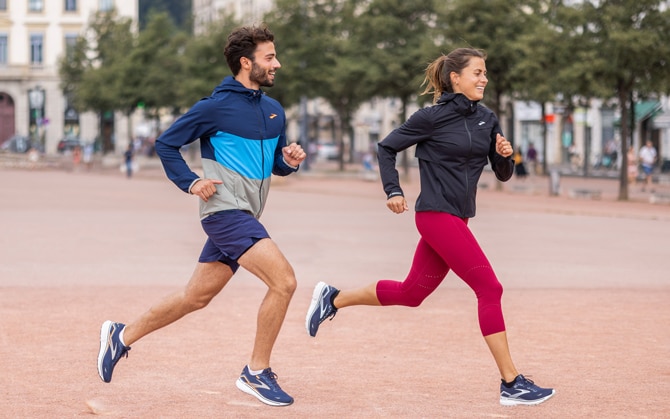
One of the great things about running is that it doesn't require much special equipment. However, there are a few things that will make running a more enjoyable and comfortable experience for you, whether you're a new runner on your couch to 5k journey, or training for your first marathon.
So, if you're asking yourself "what should I wear for running?", here's what you need to know about running outside gear.
Are you perhaps looking for something specific?
These are the topics we will be discussing today:
What are the essentials to wear while running?
The question of "what should I wear to run" is a personal one, but there are two main things you need when you're running: running shoes and comfortable clothing.
When you're out for a run, you want to be able to just focus on the run, without your clothes getting in the way. Although you can, technically, wear anything you like when you're jogging, it can make for a more comfortable experience if you choose clothing that's specifically designed for distraction-free comfort.
Here at Brooks, we make running clothes with three pillars in mind: chafe-free, constriction-free and creep-free. We think these are the three main things you want to look for when choosing clothes to run in.
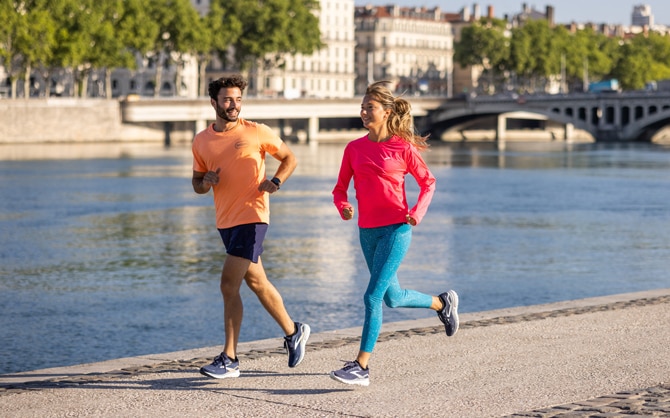
Chafe-free clothing
Chafe-free fabrics don't rub or irritate your skin. There's nothing worse than having an uncomfortable seam rubbing against you while you're trying to enjoy your run, which can happen sometimes when you opt for clothes that aren't specifically designed for running.
Running-specific clothes are made to move with your body, and they're made so that the seams don't irritate your skin. They're also made from sweat-wicking fabrics. That means the fabrics is designed to move moisture away from your skin when you sweat or get wet. Not only do dry clothes that make you feel more comfortable, but it also reduces the chances of the wet clothing rubbing against your skin as you move, helping to prevent chafing.
Clothes free from constraint
You should wear your clothes while running, they shouldn't wear you. That means they shouldn't cling or bind, and they should be easy to get on and off.
That includes your running bra. If you're a woman, it's super important that you wear a supportive bra while running. That's because your boobs move a lot when you run - in fact, it's been found that they move on average of 10cm in three directions while running.
A well-fitted run bra will hold you in and make you feel supported on the run, so you can forget about your boobs and focus on the run. Everybody is different, though, so you can use our Bra Finder to find the perfect support for your run.
Creep-free performance
Forget about pulling up your leggings or tugging on your t-shirt as you jog. You want to look out for clothing that won't ride up or down when you run.
Run Visible
As well as these three factors, if you're planning to run in the mornings or evenings, it's a good idea to wear eye-catching fabrics that'll ensure you're safe and seen.
We've worked with leading optical scientists to understand how the eye discerns objects in low-light scenarios. Using that research, we've developed the Run Visible collection, with high-contrast gear that makes it easier for drivers to see you at night.
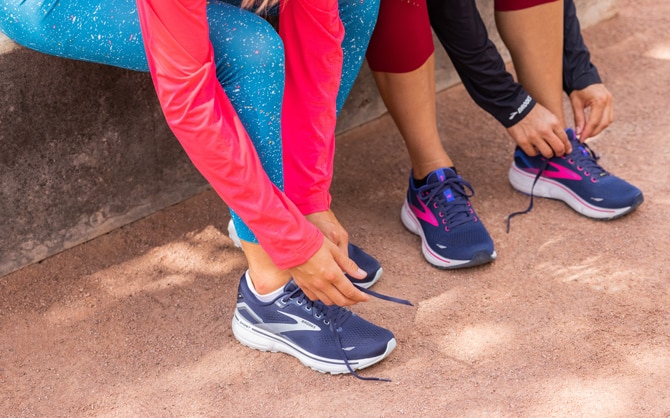
What running shoes do I need to wear on a run?
From overpronation to supination, and from support shoes to cushioning, choosing the perfect pair of running shoes can be a daunting task.
To help you get started, there are a few different things you should consider:
- What surface are you running on?
Depending on whether you're running on the roads or the trails, you'll need a different type of shoe. Road shoes are typically designed with either comfort or speed (or both!) in mind, with plenty of cushioning to keep your feet comfortable and absorb the impact of running on hard surfaces. Trail shoes are made for off road running and have grippy soles to help you navigate any surface.
- How far are you running?
If you're training for a half or full marathon, you may want more cushioning than if you're focusing on shorter distances.
- Cushioning vs lightweight
Cushioning is great for long distances, and you may even prefer the feel of a soft, comfortable shoe on your shorter runs. But for some people, cushioned shoes feel too heavy and they prefer a lightweight model. It's best to try a few different pairs and see what you like best.
- Do you need extra support?
No two runners are exactly the same, and we all have different biomechanical needs when it comes to our running shoes. Some people need more support in their shoes than others, depending on your pronation. Our unique GuideRails support system will keep you steady on your feet, and keep your body moving in its natural path.
if you're not sure which shoe is right for you, use our Shoe Finder. In just a few minutes, we'll help you to choose the best running shoe for your needs, whether you're training for a marathon or running for fun.
What clothes to wear when jogging?
Whether you're running or jogging, what you wear on the move will likely be dictated by the seasons.
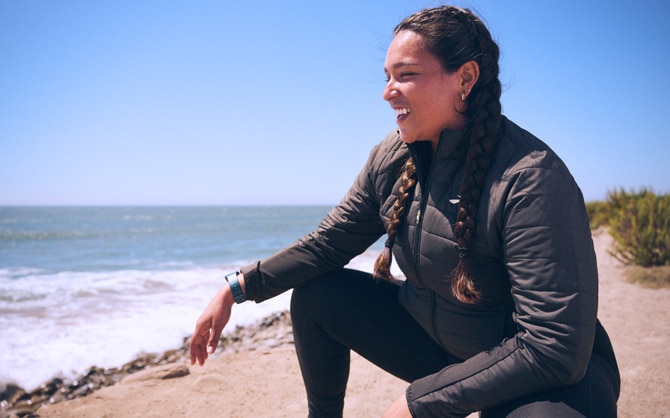
Winter essentials
Sometimes, the thought of getting out there when it's cold outside can be daunting. But with wearing the right running clothes, it's much easier to face the wind, rain and low temperatures.
Firstly, when it comes to what to wear while jogging in the winter, we recommend a good pair of tights or leggings. Keeping your muscles warm is important both for performance while you're running, and for injury prevention after your run.
You'll also want to wear a sweat-wicking base layer, and you'll likely want a warm layer on top of that to keep you cosy.
A running jacket will add wind and rain protection, so you can keep running whatever the weather's doing.
Add a pair of gloves to keep your hands toasty, and don't forget to about a hat to keep you head and ears warm.
We recommend:
- Momentum Thermal Tights (for women)
- Momentum Thermal Tights (for men)
- Shield Hybrid Jacket (for women)
- Notch Thermal Long Sleeve Top (for women)
- Notch Thermal Long Sleeve Top (for men)
Spring and autumn running clothes
You need to be prepared for anything in the shoulder seasons. It could be bright, sunny and warm, or it could be pouring down with rain!
It's a personal preference whether you wear shorts, capris or long tights on your spring and autumn runs - but it's a good idea to have a mix of options in your wardrobe, so you can choose according to the weather.
A lightweight long sleeve top is perfect for wearing over a t-shirt or vest. It'll keep the chill off on those colder days, while technical sweat-wicking fabric will ensure you stay at just the right temperature.
Finally, you never know when there might be a spring shower, so take a lightweight running jacket. Look for one that easily packs away so you can stow it in your pocket or running pack when you don't need it.
We recommend:
- Dash ½ Zip Top (for women)
- Dash ½ Zip Top (for men)
- Method Tights (for women)
- Chaser 5" 2-in-1 Shorts (for women)
- Sherpa 5" 2-in-1 Shorts (for men)
- Canopy Jacket (for women)
- Canopy Jacket (for men)

Sun's out, gun's out
You'll feel most comfortable in lightweight, sweat-wicking clothing in summer. For most people, that means shorts and t-shirts or vests - but you may like to wear longer tights on your run if that makes you feel more comfortable. If you do choose long tights over shorts, just be sure to opt for a super lightweight pair that feel like a second skin.
We recommend:
- Sprint Free Short Sleeve (for women)
- Sprint Free Tank (for women)
- Distance Short Sleeve (for women)
- Distance Short Sleeve (for men)
- Method ½ Crop Tights (for women)
- Source Tights (for men)
- Chaser 3" Shorts (for women)
- Sherpa 3" Split Shorts (for men)
What accessories should I wear on a run?
The final piece of the puzzle when thinking "what should I wear for running?" is the accessories.
After choosing the perfect pair of shoes and the right running clothing to suit the season, you don't want to be hampered by blisters on your first run. That's why special running socks are so important.
As with running clothes, you'll want to look for technical fabrics when choosing socks, as these help to wick the sweat away from your feet and avoid chafing. Running socks are often also designed without seams and with extra padding to prevent blisters.
You'll may also want to consider adding a cap to your running shopping list. They do double duty as they offer great protection against both the sun and the rain.
If you're running in winter or during a colder spring and autumn, you'll want to wear a pair of running gloves. There are lots of different gloves to choose from, from lightweight designs to thicker gloves and mitts so it comes down to personal preference - although you may want to look out for a pair that allows you to use your smartphone without having to take them off.
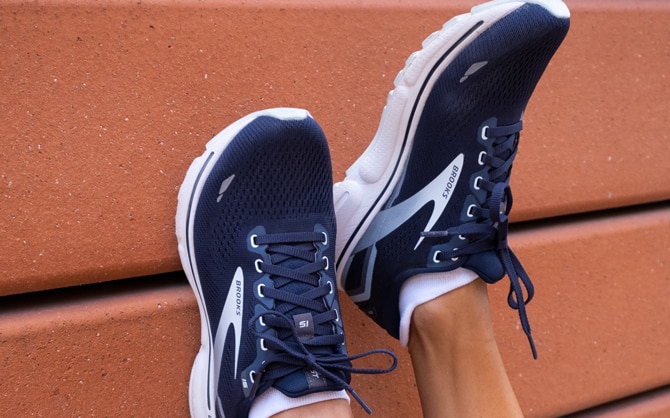
What not to wear when running?
So now you know what to wear on the run - but what about what not to wear?
It's best not to wear old shoes for running. Running shoes tend to last between 480 and 800 kilometers, which could be anything from 3 to 6 months, or even longer, depending on how much you run.
If you wear old shoes, you run the risk of injuries as they don't offer as much cushioning and support as a fresh new pair. If you start to notice any niggles, or your shoes fit differently than they did when they were fresh out of the box, it's probably a sign that it's time to splash out on a new pair.
The other key rule is to avoid cotton and heavy fabrics. Sweat-wicking material is best as it'll keep you dry and comfortable. It'll help you stay warmer when it's cold outside and cooler when it's warm out. Cotton, on the other hand, will soak up the sweat, which will leave you feeling uncomfortable and with a higher risk of chafing.
So that's it - everything you need to know about what to wear on the run. Find a comfortable pair of shoes that suit your distance, terrain and support needs and choose some sweat-wicking clothing that's appropriate for the season. Then you're good to go!
Need more Run Happy inspiration or training plans to smash any distance? Check out the Run Happy Blog for tips and advice for every distance.